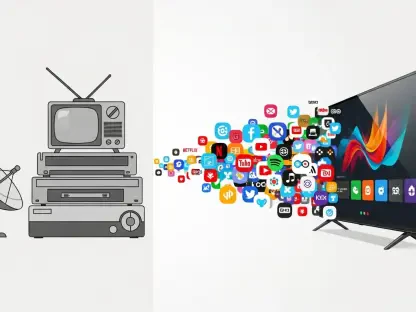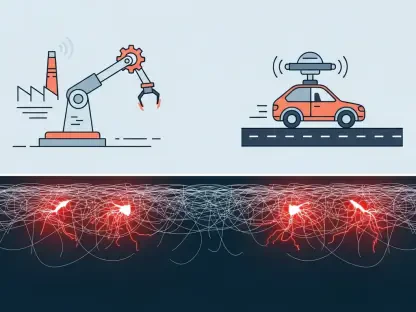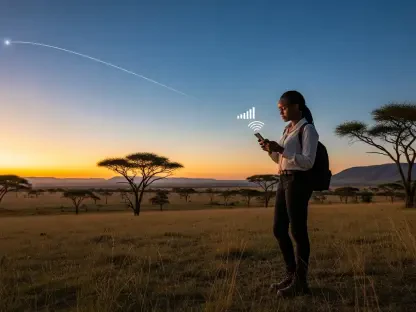Imagine a world where every individual consumes a staggering 600 gigabytes of mobile data each month, where holographic households and private aircraft are commonplace, and mobile networks operate with latencies so low they defy current imagination, painting a future that challenges the boundaries of technology. This is the audacious vision that a leading technology giant envisions for the telecom industry by the end of this decade. Such projections raise eyebrows and spark debate in a sector already grappling with slowing data growth and uncertain returns on 5G investments. This review delves into the ambitious forecasts laid out in a series of influential reports, examining their claims, feasibility, and the ripples they send through the global telecommunications landscape.
Background of the Visionary Forecasts
The “Intelligent World” reports, projecting trends for 2030 and beyond, present a transformative outlook on mobile technology and data consumption. These documents forecast an unprecedented surge in cellular data usage, estimating an average of 600 GB per person monthly by 2030, escalating to 1 terabyte by 2035. Beyond mere numbers, they paint a picture of a hyper-connected society driven by cutting-edge innovations, positioning mobile networks as the backbone of future societal shifts.
These predictions hold particular weight in an industry facing significant headwinds. With mobile data growth rates decelerating and skepticism mounting over the tangible benefits of 5G, the telecom sector is at a crossroads. The reports challenge conventional thinking, urging stakeholders to prepare for a data explosion that many doubt is realistic, setting the stage for a deeper analysis of their core assertions.
Core Features of the Predictions
Data Usage Projections
Central to these forecasts is the expectation of exponential growth in mobile data consumption. The projected leap to 600 GB per person by 2030 assumes a dramatic shift in user behavior and technology adoption, far surpassing current global averages. This would necessitate massive expansions in network infrastructure, from denser cell towers to enhanced backhaul capacities, to handle such volumes without collapse.
The implications are profound, potentially requiring telecom operators to rethink investment strategies and prioritize scalability. However, the assumptions behind these figures—such as universal access to high-bandwidth applications and devices—remain speculative, raising questions about whether such growth is driven by genuine demand or overly optimistic modeling.
Technological Innovations Envisioned
Beyond data, the vision includes futuristic technologies that seem plucked from science fiction. Holographic households, where immersive 3D communication becomes standard, and ubiquitous robotics integrated into daily life, are among the boldest claims. The reports also predict private aircraft for personal use and ultra-dense mobile networks supporting millions of connections per square kilometer with latencies under 100 microseconds.
While these ideas captivate the imagination, their technical feasibility is under scrutiny. Achieving sub-100 microsecond latency, for instance, demands breakthroughs in network architecture that may not align with practical needs. The relevance of such innovations to mainstream adoption remains unclear, as current consumer trends show limited appetite for applications requiring such extreme capabilities.
Industry Context and Comparative Insights
Current trends in the telecom sector paint a starkly different picture from the rosy forecasts. Reports from established industry players like Ericsson indicate a marked slowdown in mobile data traffic growth, with annual increases dropping to under 20% in recent analyses. Predictions for 2030 suggest a far more modest average of around 47 GB per month for smartphone users in key regions, casting doubt on the outlier status of the more extreme projections.
Diverse perspectives within the industry further highlight this disconnect. Some stakeholders, dubbed “levelers,” anticipate data growth plateauing soon due to natural limits in human consumption. Others, labeled “mountaineers,” hold hope for moderate increases driven by emerging technologies like artificial intelligence. The most ambitious forecasts stand alone as a “hot-air balloonist” approach, seemingly detached from grounded expectations and sparking intense debate over their realism.
Practical Applications and Strategic Impact
If realized, the predicted technologies could revolutionize multiple sectors, including telecom, Internet of Things (IoT), and AI-driven services. Ultra-dense networks might enable seamless smart city infrastructures, while holographic communication could transform remote work and education. These applications suggest a future where connectivity underpins every facet of life, potentially opening new revenue streams for operators.
Strategically, however, these forecasts pose dilemmas for telecom companies and vendors. The promise of transformative growth might spur investments in infrastructure that outpace actual demand, risking financial strain in an era of tight budgets. The balance between preparing for a speculative future and addressing immediate market needs becomes a critical consideration for decision-makers navigating this uncertain terrain.
Challenges and Industry Skepticism
Significant hurdles stand in the way of these ambitious projections. Technical implausibility is a primary concern, with experts dismissing targets like sub-100 microsecond latency as unnecessary for most applications. Critics argue that even a 10-millisecond latency suffices for current and foreseeable uses, questioning the value of chasing such extreme benchmarks.
Economic pressures on technology vendors add another layer of complexity. With global operators scaling back on 5G investments due to underwhelming returns, there is skepticism about the motives behind such grandiose predictions. Analysts warn that credibility could be at stake, particularly in international markets where trust is already fragile, and operators risk misallocating resources based on inflated expectations.
Moreover, industry voices express concern over the broader implications of embracing these forecasts. The potential for misguided capital expenditure looms large, as does the danger of diverting focus from pressing issues like network reliability and affordability. Such criticisms underscore the need for a cautious approach to integrating these visions into strategic planning.
Future Trajectory and Emerging Possibilities
Looking ahead, the trajectory of these predictions hinges on technological advancements that could partially validate some claims. Developments in AI, for instance, might drive unexpected data demands, though not necessarily to the extent envisioned. The integration of new devices and applications over the next few years will be crucial in determining whether these forecasts gain traction or remain speculative.
Long-term impacts on the telecom industry could involve a delicate balance between innovation and practicality. While pushing boundaries is essential for progress, aligning investments with tangible market needs will prevent overreach. The evolution of global connectivity standards and consumer behaviors will ultimately shape whether this bold vision finds a foothold in reality.
Final Reflections
Looking back, this exploration of a pioneering set of mobile technology forecasts revealed a vision that was both captivating and contentious. The debate surrounding projected data surges and futuristic innovations underscored deep divisions within the telecom sector about the pace and nature of future growth. While the ambition to redefine connectivity inspired imagination, the skepticism from industry peers highlighted a grounding in practical constraints that could not be ignored.
Moving forward, stakeholders must prioritize evidence-based strategies, focusing on incremental advancements that address real-world demands. Collaborative efforts between vendors and operators to test emerging technologies like AI in controlled environments could bridge the gap between speculation and application. Ultimately, the path ahead lies in fostering innovation with pragmatism, ensuring that the telecom industry evolves sustainably toward a connected future without losing sight of current realities.









